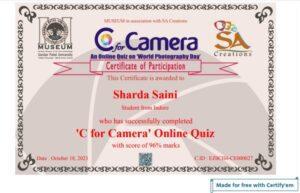
Organizer : Museum of Sardar Patel University, Gujarat, India in association with SA Creations, India
World Photography Day
About the Quiz
- All Questions are based on general knowledge and well known facts of photography.
- The ‘C for Camera’ Online Quiz consists of 25-MCQs – Multiple Choice Questions. Please read the instructions carefully before you answer the Questions. You will need to choose correct one from the given options.
- Each question carries 4 points.
- EVERY PARTICIPANT will receive an E-Certificate on email.
- After submission of the Quiz, you will get your score instantly on screen by clicking the button “View Score”….
- This is a purely fun-learn activity and If you wish, You can participate multiple time by using the same link to improve your score.
- The best practice would be to take a [screenshot] of your score and share proudly on your social media accounts ….
All the best….
Apply Link
for any query or suggestion please write to us on
museum2.sardarpateluniversity@gmail.com
100% Correct Answers Here
1. What is DSLR stands for?
4/4
a. Dynamic Short Lens Router
b. Detail Signal Lens Reflex
c. Digital Single Lens Reflex
d. Decode Sigma Lens Roman
2. When the World Photography Day is being observed?
0/4
a. 19 August
b. 20 August
c. 18 August
d. 18 June
3. What was the theme of world photography day 2022?
4/4
a. Pandemic Lockdown through the Lens
b. Understanding Clouds
c. Transcending the boundaries of language
d. Dedicated to history
4. When was the ‘World Photography Day’ first observed?
4/4
a. 1837
b. 1861
c. 1839
d. 1862
5. When the first durable colour photograph was taken?
4/4
a. 1837
b. 1839
c. 1861
d. 1862
6. By whom the camera was invented?
4/4
a. Nicephore Niepce
b. Philo Taylor Farnsworth
c. Hans Lippershey
d. Martin Cooper
7. Who started world photography day?
4/4
a. Joseph Nicephore Niepce
b. Louis Daguerre
c. Both of the above
d. None of the above
8. Who is the father of Photography?
4/4
a. Charles Babbage
b. Joseph Nicéphore Niépce
c. J.P.Lemiere
d. Johan Freidrich Voigtlander
9. Who is the father of Indian Photography?
4/4
a. Raghu Rai
b. Rangaswamy Narasimhan
c. TS Satyan
d. Guru Dutt
10. Which photography technique involves capturing a sequence of images and then combining them to show the passage of time in a single frame?
4/4
a. Slow Motion Photography
b. Time-lapse photography
c. Fast Forward Photography
d. Fast and Furious Photography
11. In photography, what term refers to the blurring of the background to make the main subject stand out more prominently?
4/4
a. Bohemian effect
b. Booster effect
c. Bokeh effect
d. Broken effect
12. Which National Geographic photographer’s iconic portrait ‘Afghan Girl’ became a symbol of the refugee crisis in the 1980s?
4/4
a. Steve Jobs
b. Steve Madden
c. Steve Carell
d. Steve McCurry
13. What is the phenomenon in photography where light appears to radiate from a point source, creating a dramatic effect?
0/4
a. Lens fogging
b. Lens projection
c. Lens flare
d. Lens Fire
14. What camera setting determines how long the camera’s sensor is exposed to light, impacting the amount of motion blur and light captured in an image?
4/4
a. Scooter speed
b. Shutter speed
c. Object Speed
d. Light Speed
15. What photographic technique involves using extreme close-up lenses to capture intricate details of very small subjects like insects or flowers?
4/4
a. Macro photography
b. Mono photography
c. Minute photography
d. Mute photography
16. Who is credited with inventing the first successful permanent photograph in 1826, using a process known as heliography?
4/4
a. Nicolas Cage
b. John Travolta
c. Joseph Nicéphore Niépce
d. Joseph McLeod
17. Which photography term describes the range of tones between the lightest and darkest areas in an image?
4/4
a. Dramatic range
b. Dynamic range
c. Static range
d. Strategic range
18. Which type of lens has a fixed focal length and is valued for its ability to capture crisp, distortion-free images?
4/4
a. Prime lens
b. Primate lens
c. Primorial lens
d. Preamble lens
19. What term describes the visual distortion that occurs when a camera is tilted, causing vertical lines to converge or diverge in an image?
4/4
a. Perspective conjunction
b. Perspective construction
c. Perspective junction
d. Perspective distortion
20. Which photography technique involves capturing a scene using a camera with an extremely fast shutter speed, freezing high-speed motion in a single frame?
4/4
a. Low-frame photography
b. High-speed photography
c. Low-light photography
d. High-risk photography
21. In photography, the term ‘exposure triangle’ refer to the relationship between whom?
4/4
a. flash, lens and tripod
b. reflector, box lights and studio lights
c. aperture, shutter speed and ISO
d. batteries, remote and lens lid
22. What photography technique involves intentionally moving the camera during a longer exposure to create abstract and painterly effects?
4/4
a. Indian camera movement (ICM)
b. Intentional camera movement (ICM)
c. Inbuilt camera movement (ICM)
d. Inferior camera movement (ICM)
23. What type of photography involves capturing images of celestial objects such as stars, planets, and galaxies?
4/4
a. Aerialphotography
b. Asiaticphotography
c. Astrophotography
d. Agraophotography
24. What term describes the point in a photograph where all perspective lines seem to converge, typically located at eye level and creating a sense of depth?
4/4
a. Horizon line
b. Zig Zag line
c. Hormonal line
d. Vistara line
25. What is the technique of intentionally overexposing an image to create a washed-out, dreamy effect called?
4/4
a. Over-cover
b. Over-write
c. Over-exposure
d. Over-power
